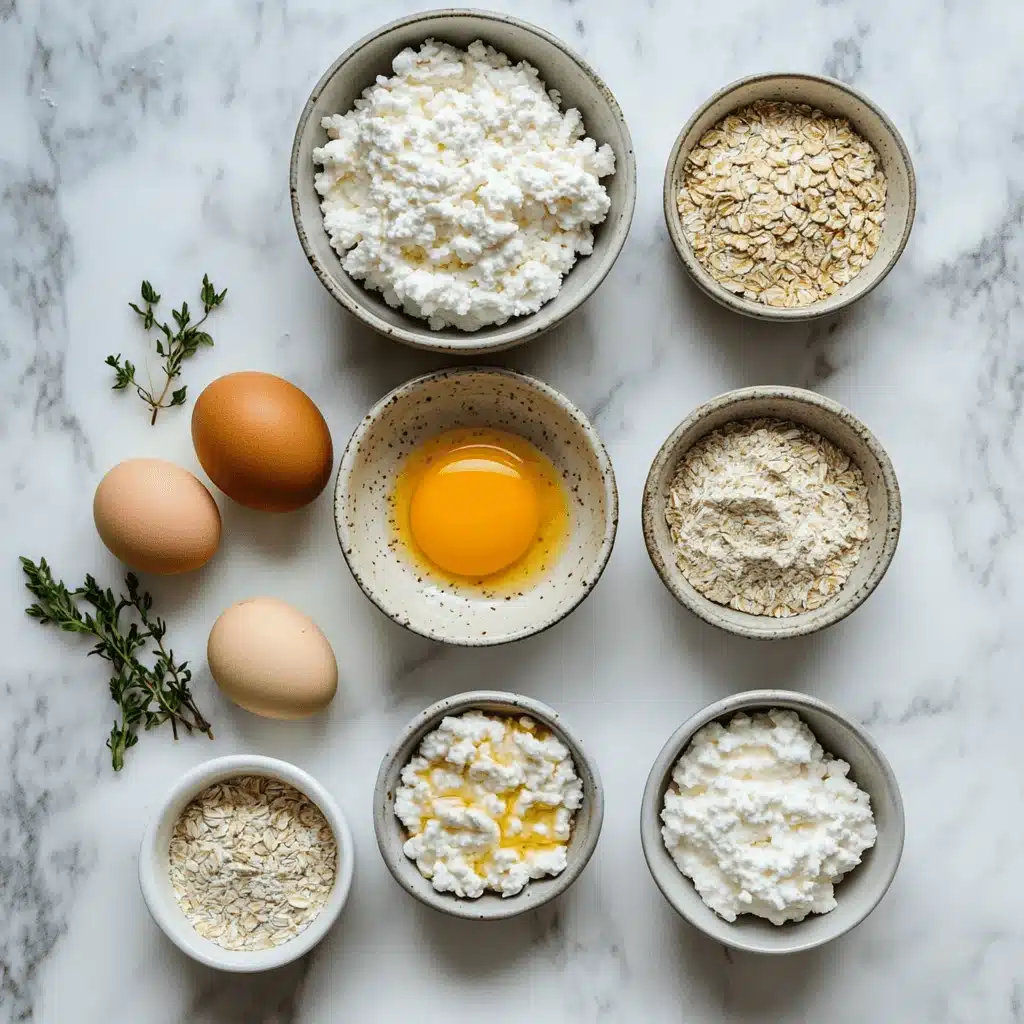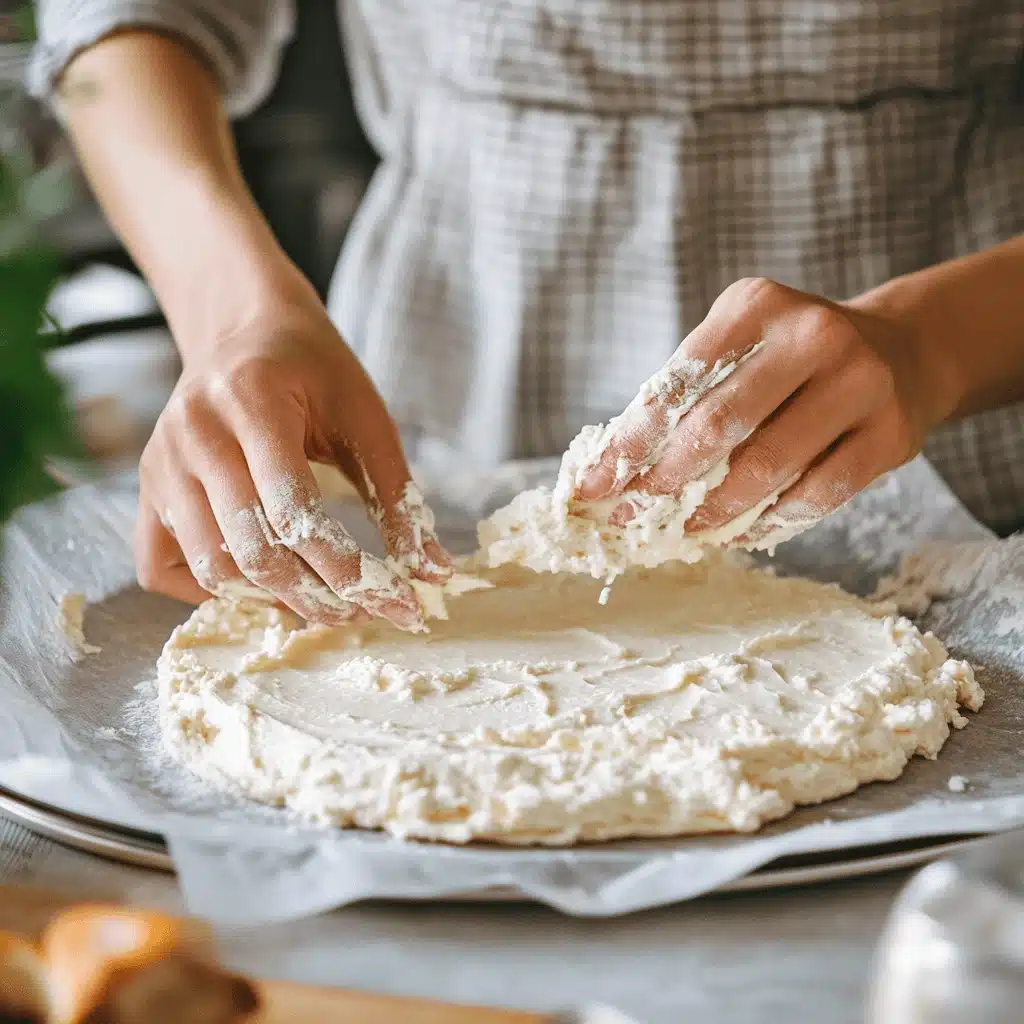
Cottage Cheese Pizza Crust – Healthy, Crisp, and Protein-Packed
- Total Time: 30 minutes
- Yield: 1 medium crust 1x
Description
A high-protein, low-carb pizza crust made with cottage cheese, perfect for a healthy and satisfying pizza night.
Ingredients
1 cup cottage cheese (low-fat or full-fat)
2 large eggs
½ cup oat flour or almond flour
½ tsp baking powder
Salt, garlic powder, and Italian herbs to taste
Instructions
1. Preheat the oven to 400°F (200°C) and prepare a parchment-lined baking tray.
2. Blend cottage cheese and eggs until smooth and creamy.
3. Stir in flour, baking powder, and seasonings until a thick batter forms.
4. Let the mixture rest for 5 minutes to absorb moisture.
5. Spread dough evenly into a ¼-inch thick circle or rectangle.
6. Bake for 15-18 minutes or until the crust is golden and firm.
7. Top as desired and bake again for 5-7 minutes.
Notes
Drain cottage cheese first for a firmer crust.
Add herbs, red pepper flakes, or garlic to boost flavor.
Pairs well with roasted vegetables, feta, or lean meats.
- Prep Time: 10 minutes
- Cook Time: 20 minutes
- Category: Healthy Pizza
- Method: Baked
- Cuisine: Fusion
Nutrition
- Serving Size: 1 slice
- Calories: 110
- Sugar: 1g
- Sodium: 220mg
- Fat: 6g
- Saturated Fat: 2g
- Unsaturated Fat: 3.5g
- Trans Fat: 0g
- Carbohydrates: 4g
- Fiber: 1g
- Protein: 10g
- Cholesterol: 70mg
Table of Contents
Craving a pizza night without the guilt? This article introduces you to an unexpectedly delicious secret: cottage cheese pizza crust. With high protein, low carbs, and a crisp bite, it’s the perfect solution for health-conscious foodies and curious cooks alike. We’ll explore how to make it, why it works, and how to troubleshoot common issues like sogginess. I’ll also share how this crust became my go-to for Friday nights. If you’re looking to blend comfort and creativity in your kitchen, this recipe’s for you.
The Story Behind My Cottage Cheese Pizza Crust
1. When Comfort Meets Healthy in My Southern Kitchen
Hi, I’m Laura Carter, a 45-year-old home cook from Asheville, North Carolina. On a chilly Sunday last winter, I stood in my kitchen, craving pizza but wanting something that didn’t leave me sluggish after. That’s when I remembered the leftover cottage cheese in my fridge. My grandmother Mabel always believed that the best meals came from what was on hand. So, I took that spirit and made my first batch of cottage cheese pizza crust. It wasn’t perfect-but it had promise.
After a few tries, I found the right mix-protein-packed, light on carbs, and wonderfully crisp around the edges. These days, it’s one of my favorite base recipes for healthy dinners. Sometimes I top it with caramelized veggies and lean protein, or when I’m in the mood for something cozy, I pair it with a bowl of lean beef patty and greens on the side. The flavor and texture are so good, I don’t miss the traditional dough one bit.
2. Why Cottage Cheese Works for a Pizza Crust
Here’s what makes cottage cheese pizza crust such a winner: its balance of creaminess and structure. The curds melt just enough to create moisture, but not so much that the crust gets soggy. Combined with ingredients like oat flour or ground flaxseed, it bakes into a firm, chewy base that holds up under toppings.
It’s also surprisingly versatile. For a low-sodium dinner, I top it with roasted veggies and a spoonful of creamed spinach. And when I want a fresh bite on the side, I add a scoop of fermented feta for a tangy, gut-healthy bonus.
This crust is proof that health and comfort can absolutely share the same plate.
How to Make Cottage Cheese Pizza Crust
1. Ingredients You’ll Need for Cottage Cheese Pizza Crust
Making cottage cheese pizza crust at home is surprisingly easy. Most of these ingredients are already in your kitchen if you’re into healthy cooking. Here’s what you’ll need:
| Ingredient | Amount |
|---|---|
| Cottage Cheese (low-fat or full-fat) | 1 cup |
| Eggs | 2 large |
| Oat Flour or Almond Flour | ½ cup |
| Baking Powder | ½ tsp |
| Salt, Garlic Powder, Italian Herbs | To taste |

Optional toppings: roasted vegetables, lean meats, or leftovers like this lean beef patty recipe sliced thin.
2. Step-by-Step Instructions (With Pro Tips)
1. Preheat your oven to 400°F (200°C) and prepare a baking tray with parchment paper to prevent sticking.
2. Blend cottage cheese and eggs until smooth. You want a creamy texture, not lumpy.
3. Mix in flour, baking powder, salt, and herbs until a soft dough forms. Let it sit for 5 minutes to thicken.
4. Spread the dough into a ¼-inch-thick circle or rectangle. Make edges a bit thicker to hold toppings.
5. Bake for 15-18 minutes, or until the crust turns golden and feels firm in the center.
6. Remove, top with your favorite healthy pizza ingredients (roasted garlic, veggies, a sprinkle of homemade fermented feta), then bake again for 5-7 minutes until everything is melty.

The cottage cheese base turns out sturdy and satisfying, with crunchy edges and a tender middle-no mushy center in sight. It’s also freezer-friendly, making it great for quick dinners or healthy lunches. For a full-on balanced meal, I love serving it with a bowl of 3-ingredient creamed spinach or a light lucuma ice cream for dessert.
Why Cottage Cheese Crust Is Healthier Than Traditional Dough
1. Nutritional Benefits of Cottage Cheese Pizza Crust
Unlike typical pizza crusts that rely on refined flour and oil, cottage cheese pizza crust delivers protein, calcium, and healthy fats with fewer carbs. Here’s a quick comparison that highlights the difference:
| Nutrition (Per Slice) | Cottage Cheese Crust | Traditional Dough |
|---|---|---|
| Calories | 110 | 190 |
| Protein | 10g | 3g |
| Net Carbs | 4g | 22g |
| Fat | 6g | 5g |
This crust is an excellent choice for anyone following a high-protein, low-carb, or diabetic-friendly meal plan. It’s also naturally gluten-free if you use almond flour. For those managing blood sugar or looking to avoid processed carbs, this crust is a game-changer.
2. Ideal for Diets and Healthy Eating Lifestyles
What makes cottage cheese pizza crust so special is its flexibility. It supports various health goals-from weight loss to building lean muscle. And because the base is mild in flavor, it works with toppings from Mediterranean to low-sodium styles.
For a post-workout meal, I love topping it with grilled chicken, baby spinach, and a drizzle of yogurt sauce. For lighter dinners, I’ll slice it into squares and serve it alongside a bowl of fermented feta or top it with high-protein wagyu meatballs.
Compared to heavy wheat dough, this version leaves you feeling energized instead of bloated. It’s part of why I love sharing this recipe with my online community-it’s delicious, approachable, and nourishing all at once.
Tips, Variations & How to Avoid a Watery Cottage Cheese Crust
1. Avoiding a Watery Cottage Cheese Pizza Crust
If your cottage cheese pizza crust turns out soft or soggy, the culprit is almost always excess moisture. Cottage cheese varies by brand-some are wetter than others. Here’s how to fix it:
- Drain the cottage cheese: Place it in a fine mesh strainer or wrap it in a paper towel and press gently.
- Use a food processor: Blending creates a uniform texture, but don’t over-blend into liquid.
- Let the dough rest: After mixing, give it 5-10 minutes. This allows the flour to absorb excess moisture.
- Pre-bake the crust before adding toppings. This step is essential to keep the center firm and prevent unwanted mushiness.
Also, avoid overloading it with sauce or watery vegetables until after the first bake. Roasted or sautéed toppings, like those used in this pan roast recipe, keep moisture under control and flavor turned up.
2. Flavor Variations and Creative Toppings
This cottage cheese pizza crust is just the beginning-you can easily make it your own. Try these upgrades:
- Add-ins: Mix chopped fresh herbs, nutritional yeast, or minced garlic into the dough.
- Spicy crust: Stir in a pinch of red pepper flakes or a spoonful of harissa for a bold, spicy kick.
- Sweet version: Leave out the herbs and salt, then top with almond butter, banana slices, and a drizzle of honey-like a high-protein twist on cottage cheese banana pancakes.
- Mediterranean-style: Use sundried tomatoes, olives, and a crumble of homemade fermented feta cheese.
Topping versatility is what makes this crust so useful. I’ve even turned it into mini flatbreads and dipped them into 3-ingredient creamed spinach for an easy appetizer.
The key to success is keeping things balanced: dry your cheese, pre-bake the base, and have fun with fresh, bold flavors.

Frequently Asked Questions About Cottage Cheese Pizza Crust
Can I make pizza dough with cottage cheese?
Absolutely. Cottage cheese works surprisingly well in place of traditional flour-based doughs. When combined with ingredients like eggs and almond or oat flour, it forms a soft, protein-rich dough that bakes into a sturdy, flavorful crust. It’s especially popular in low-carb and gluten-free kitchens because it’s both nutritious and satisfying. You’ll find it behaves differently from wheat-based dough, but once baked, it holds its shape and crisps nicely-especially when paired with roasted veggies or lean protein like wagyu meatballs.
Does cottage cheese melt on pizza?
Cottage cheese doesn’t melt in the same way as mozzarella or cheddar. Instead of stretching, it softens and browns slightly. When used in crust or as a topping, it brings a creamy texture and mild tang. Some people blend it to create a smooth, ricotta-like base for white pizzas or combine it with melted cheese to improve texture. If you’re after a more traditional melt, you can layer it under mozzarella or use it in small dollops for a rustic feel.
What is the healthiest crust for pizza?
That depends on your goals, but cottage cheese pizza crust ranks high for those seeking a low-carb, high-protein option. It’s gluten-free when made with almond flour and skips the refined flours found in most takeout versions. Compared to cauliflower crusts, it’s sturdier and has more natural protein. Serve it with nutrient-rich sides like creamed spinach or a simple cucumber salad to keep the whole meal balanced and nourishing.
Why is my cottage cheese pizza bowl watery?
If your crust or pizza bowl feels soggy, excess moisture is likely to blame. Cottage cheese can contain a lot of liquid, especially lower-fat versions. The fix? Drain it before using, and avoid piling on watery toppings like fresh tomatoes until after the first bake. You can also let the dough sit for a few minutes after mixing to help it firm up. These simple steps ensure your cottage cheese pizza crust comes out crispy, not soggy.
Conclusion
If you’re looking for a healthier way to enjoy pizza night without giving up flavor or satisfaction, cottage cheese pizza crust is a fantastic choice. It’s easy to make, packed with protein, and adaptable to whatever toppings you’re craving-from roasted veggies to tangy homemade fermented feta.
This crust has become a regular part of my kitchen rhythm, and I love how it fits into both weeknight meals and more special, slow-cooked occasions. Whether you’re watching carbs, avoiding gluten, or just trying something new, it offers a wholesome base with none of the heaviness of traditional dough.
Don’t be afraid to experiment. From sweet versions to savory flatbreads, this recipe invites creativity. And when paired with sides like 3-ingredient creamed spinach or even a light scoop of lucuma ice cream, it becomes a meal you’ll want to make again and again.
So grab your cottage cheese and turn your next pizza night into something nourishing, simple, and seriously delicious.
Follow me on Facebook for daily updates and community fun.


1 thought on “Cottage Cheese Pizza Crust – Healthy, Crisp, and Protein-Packed”